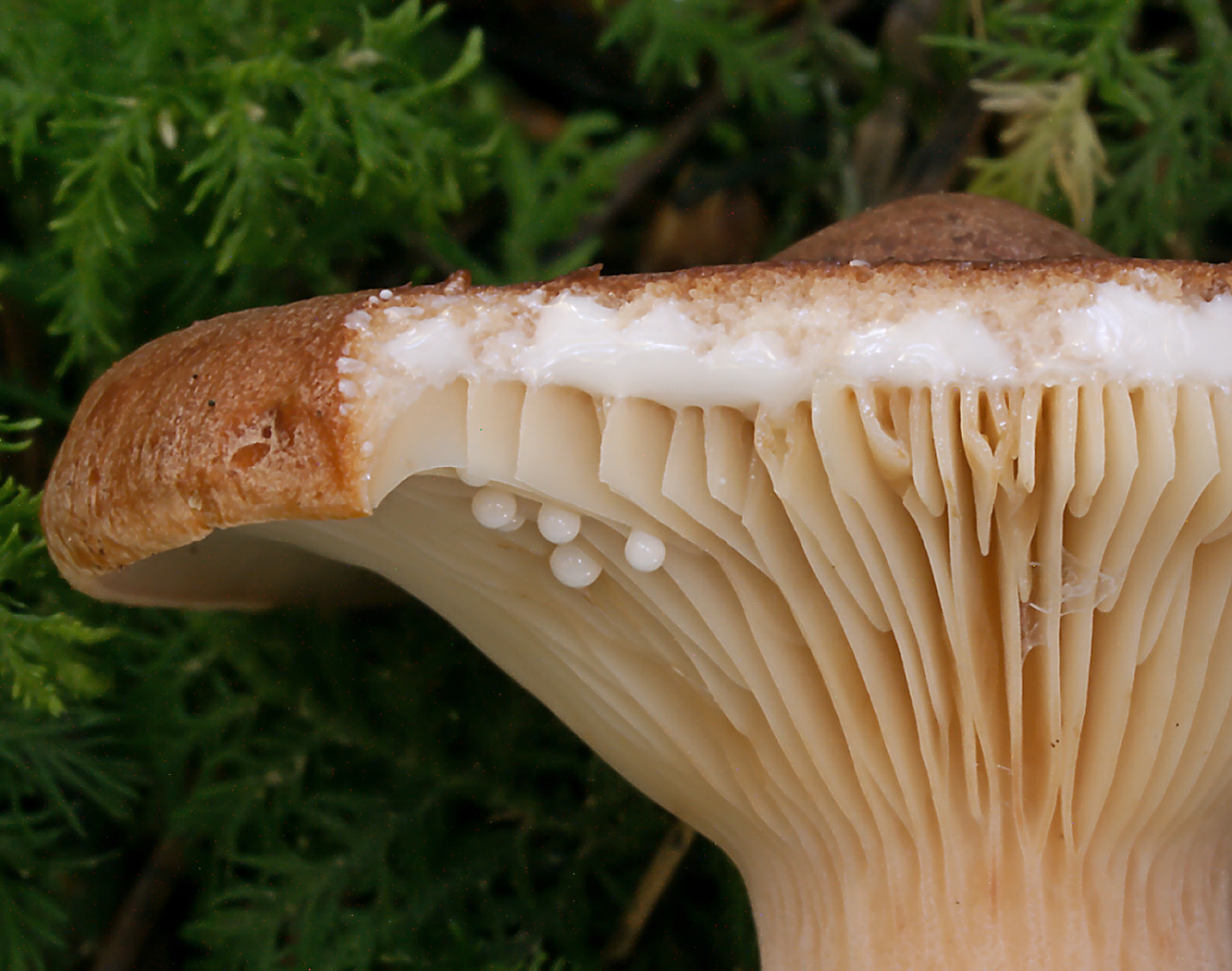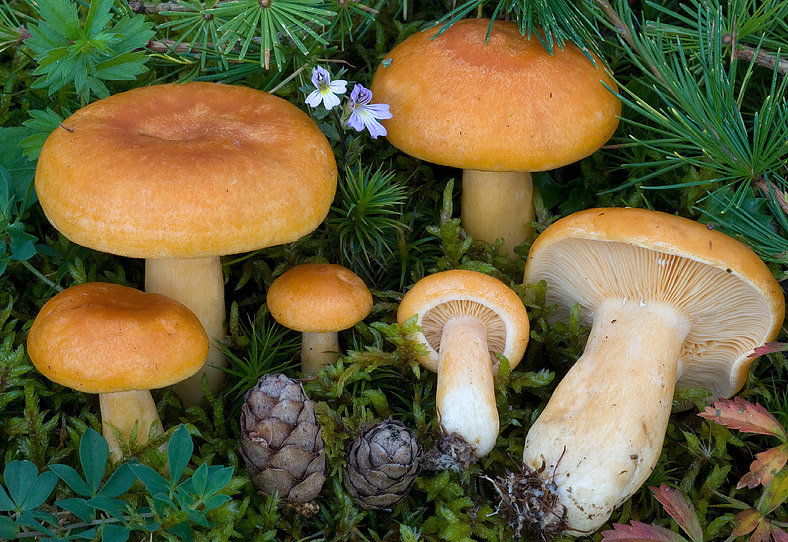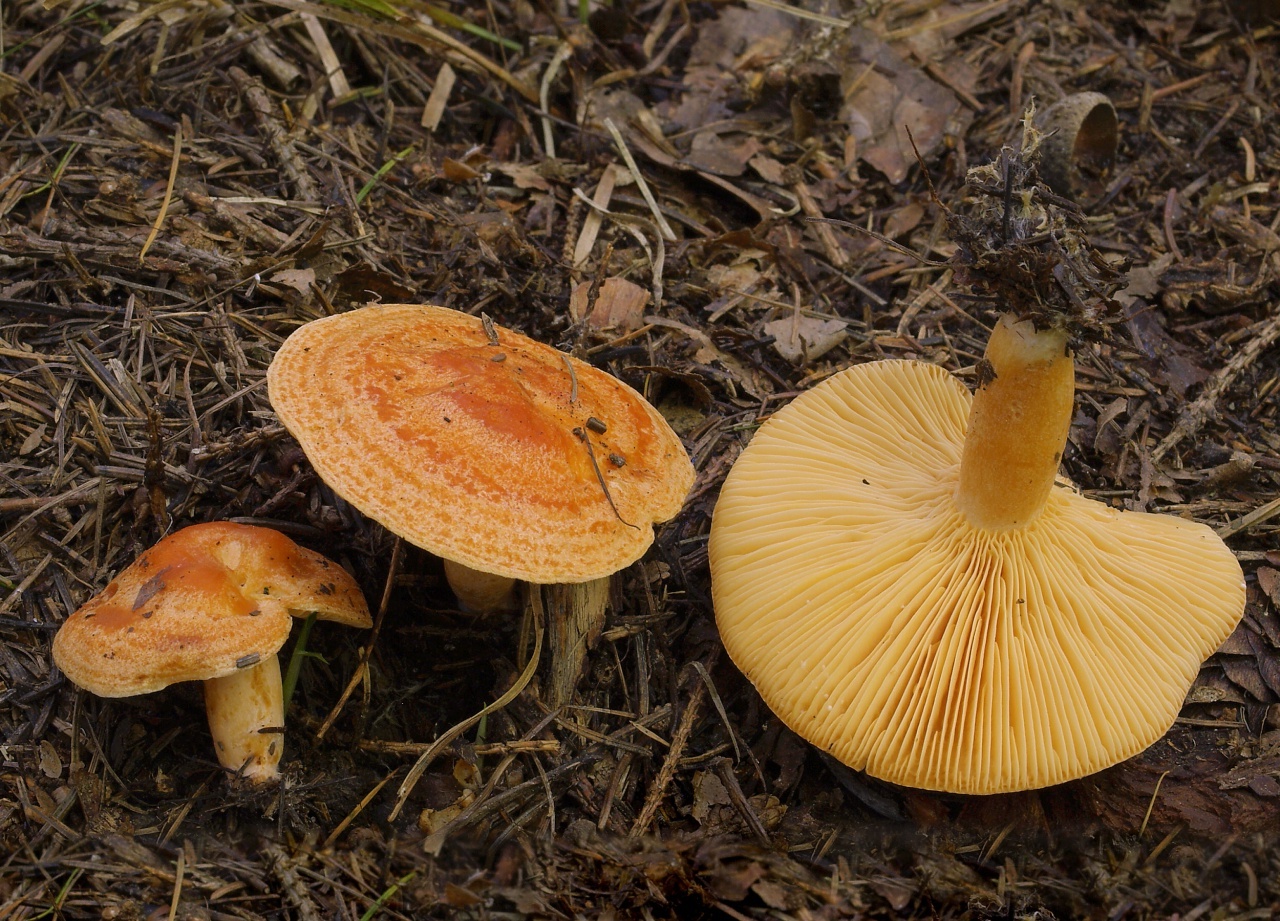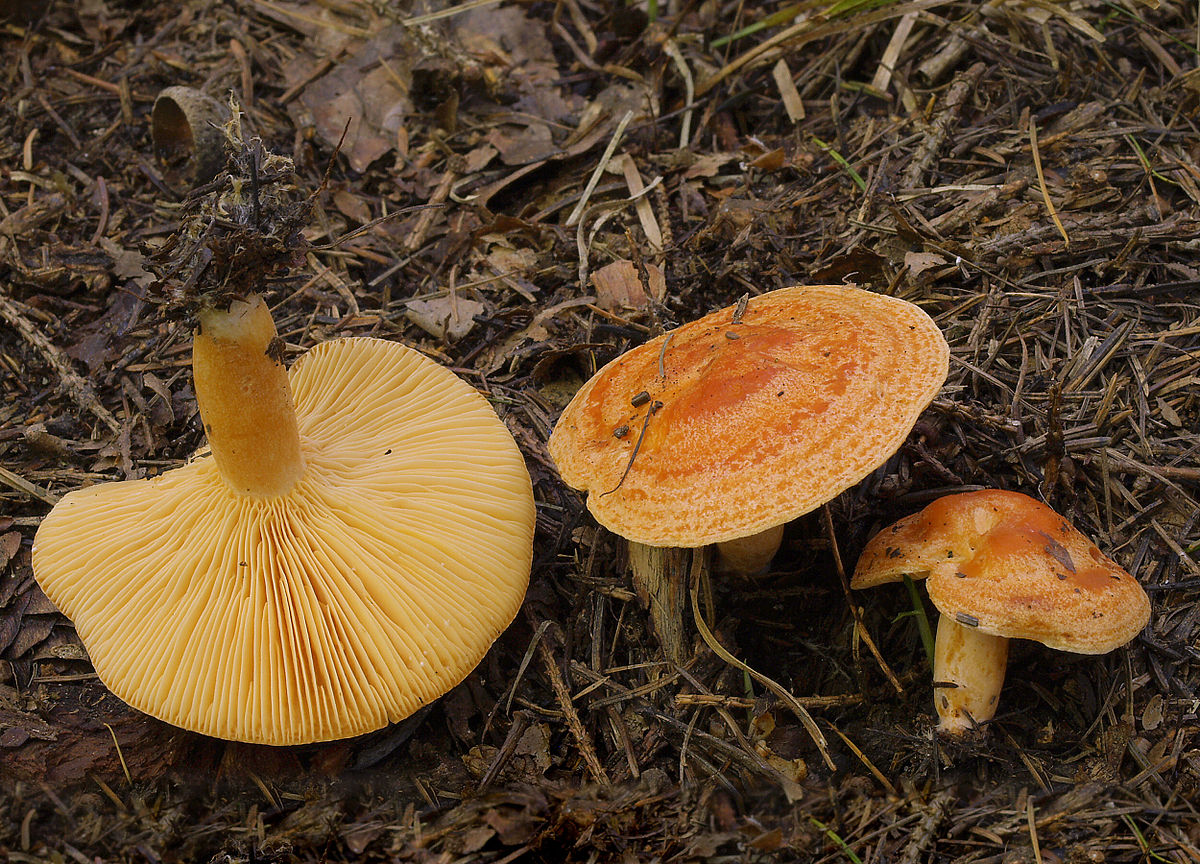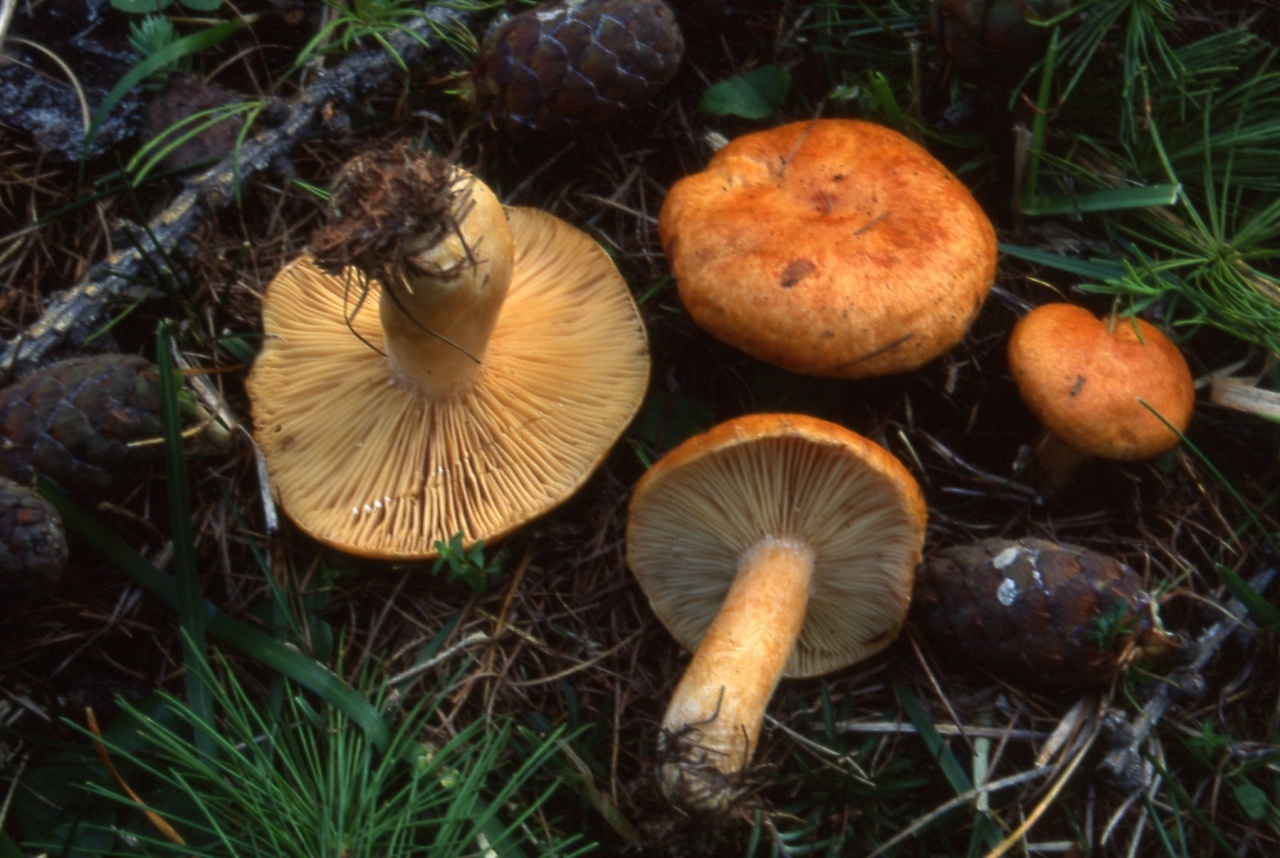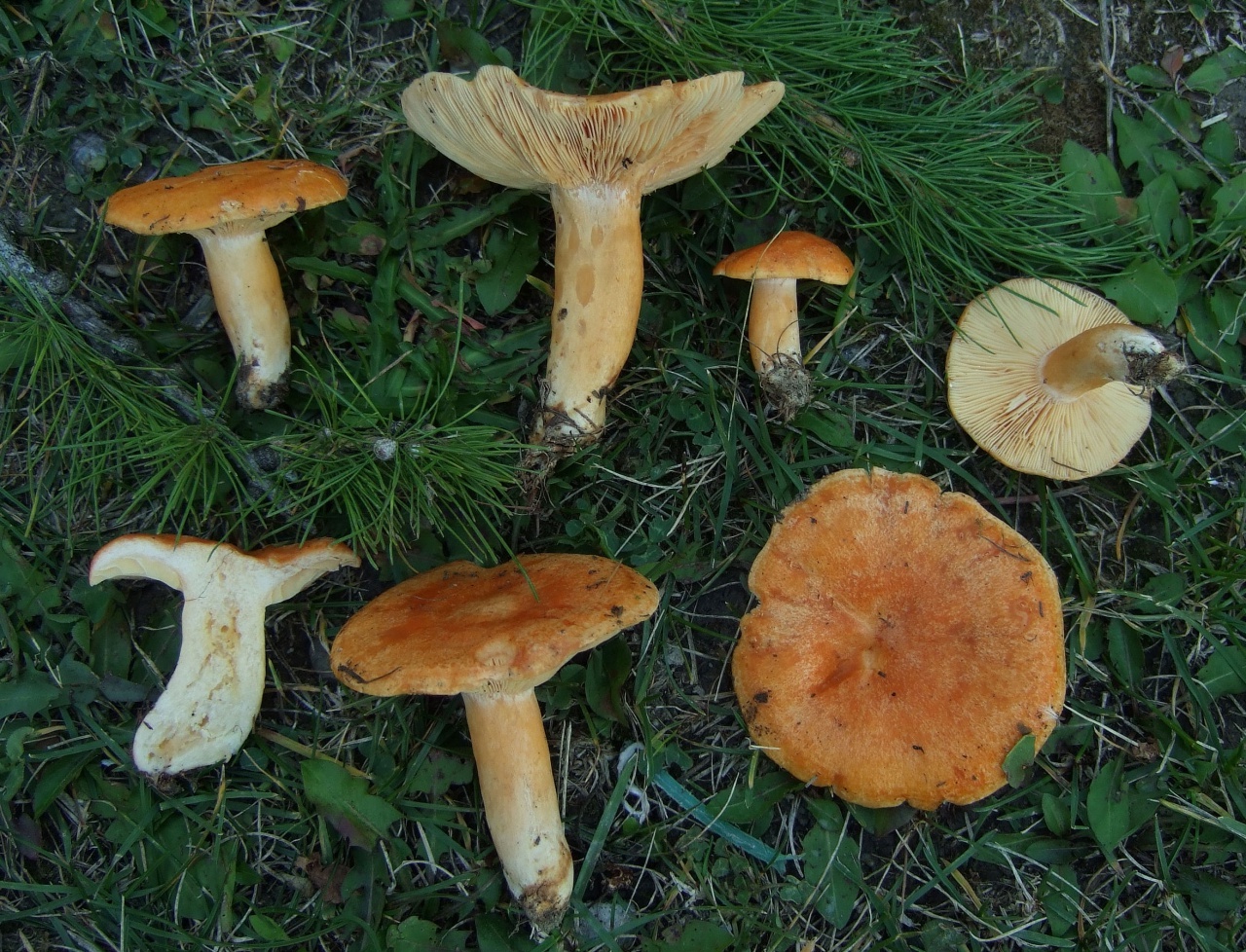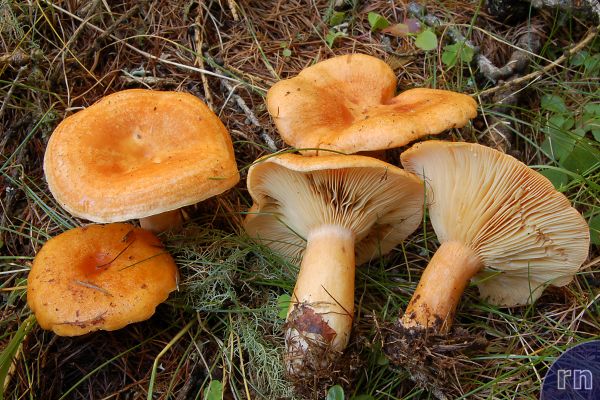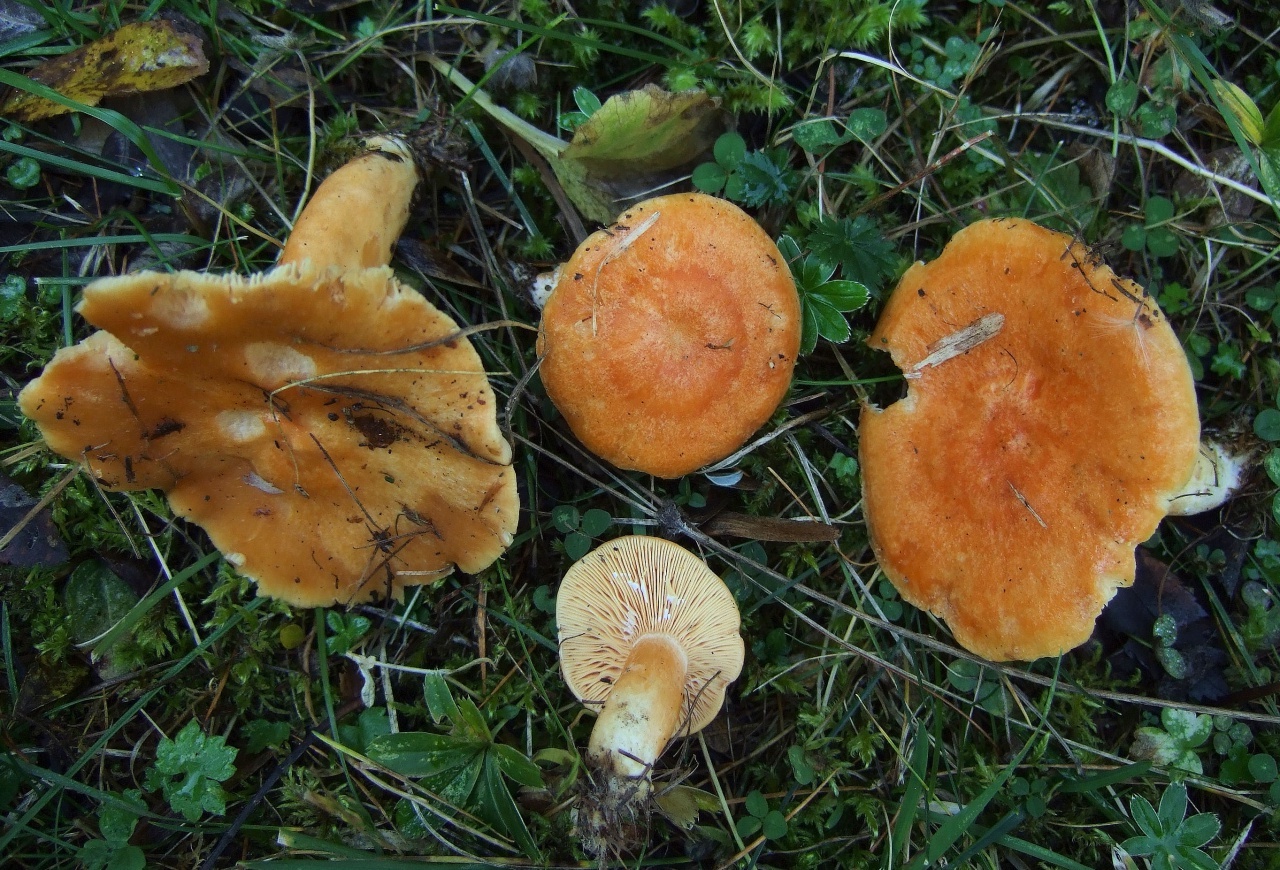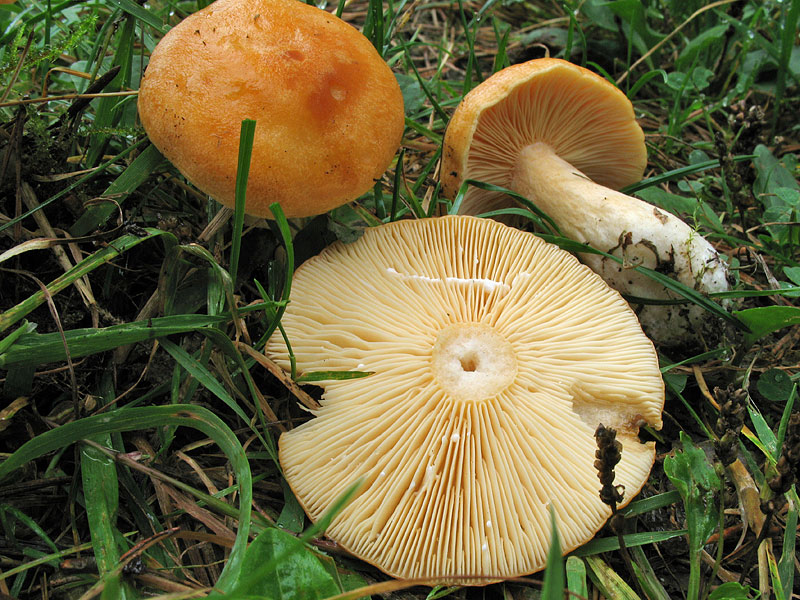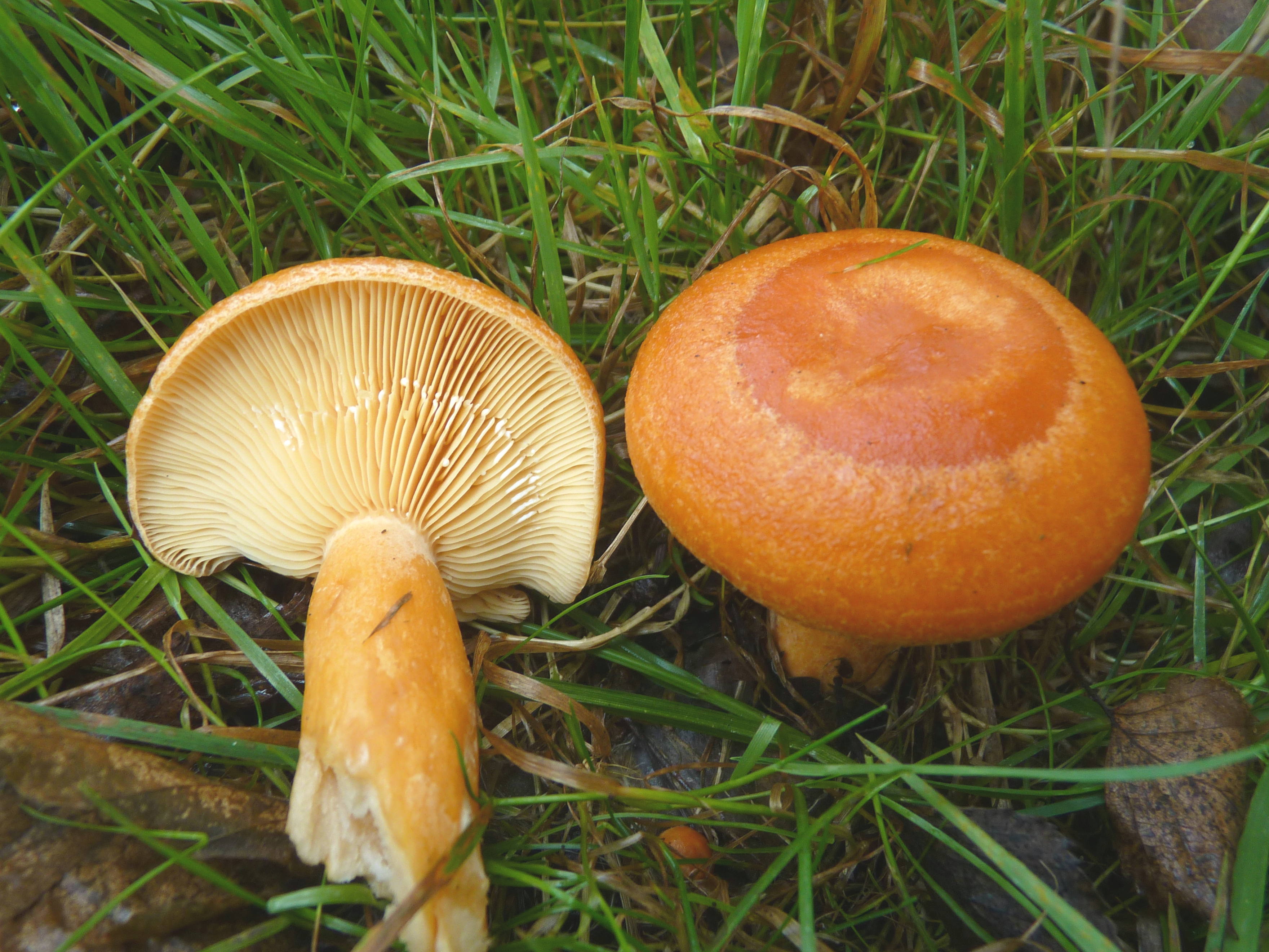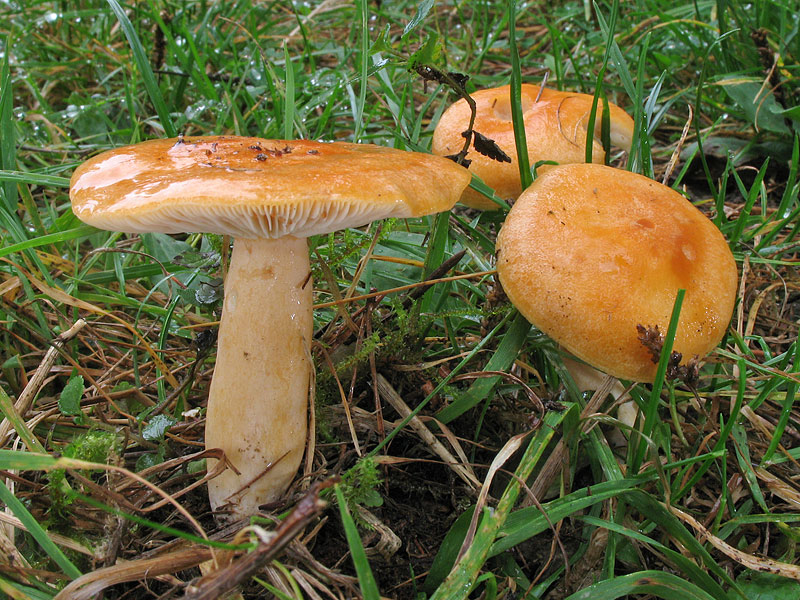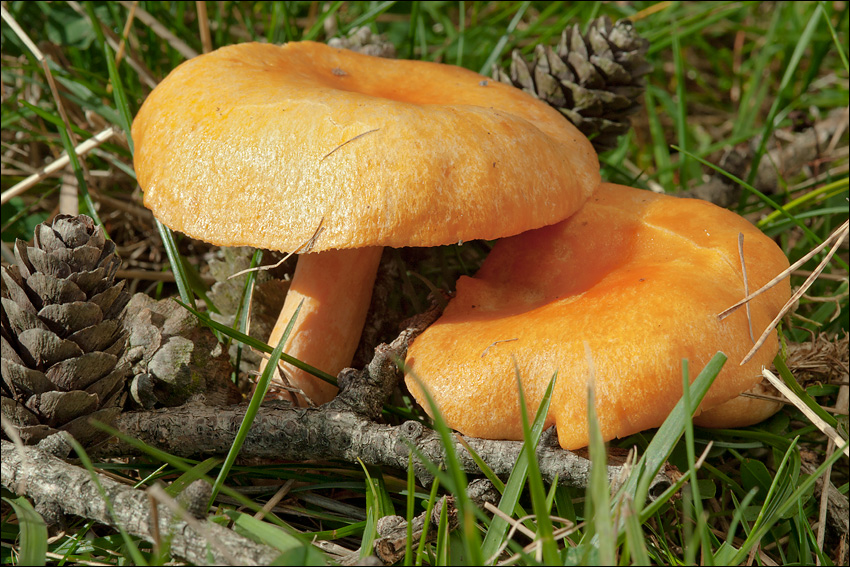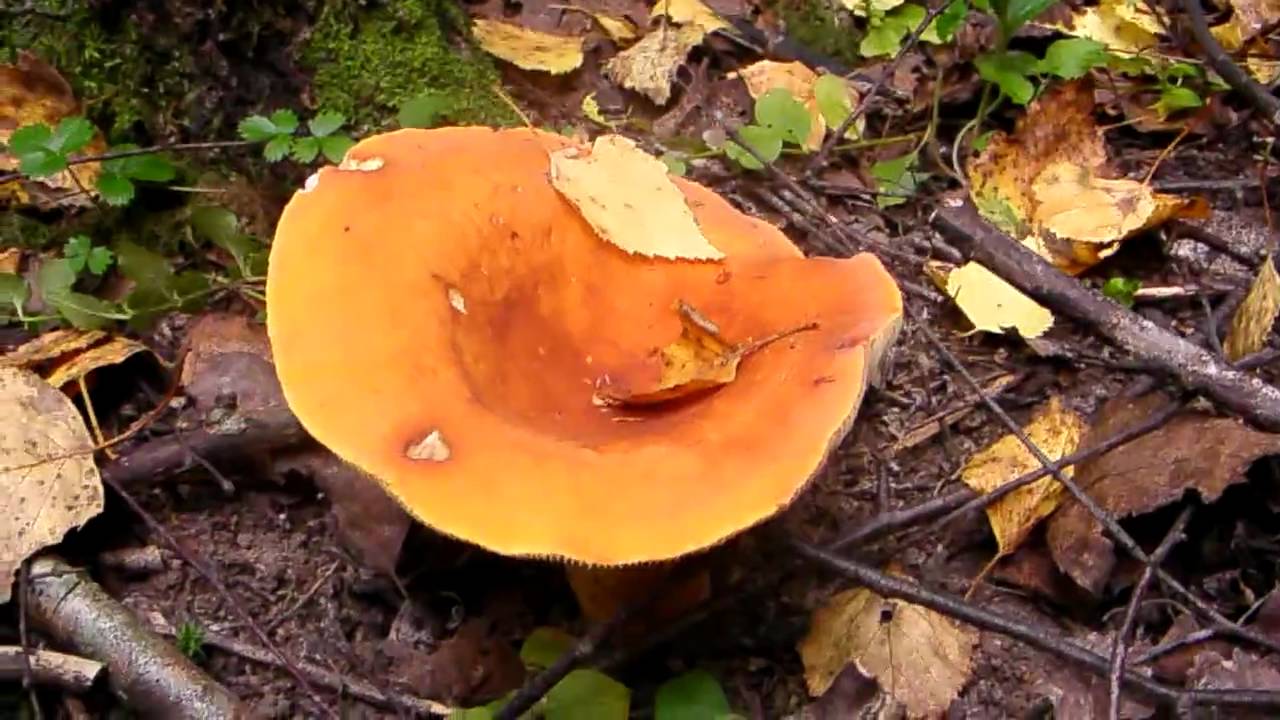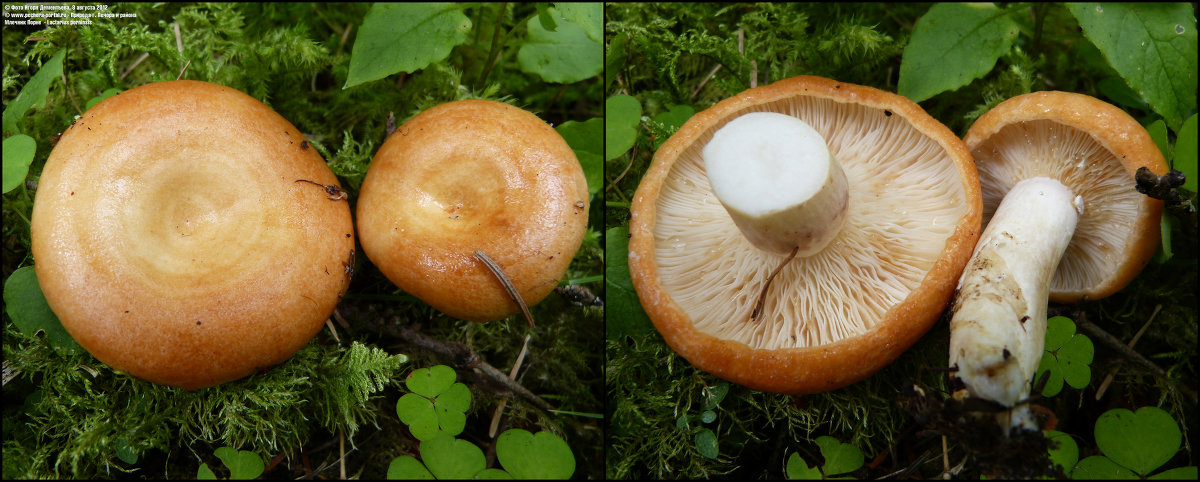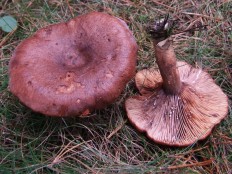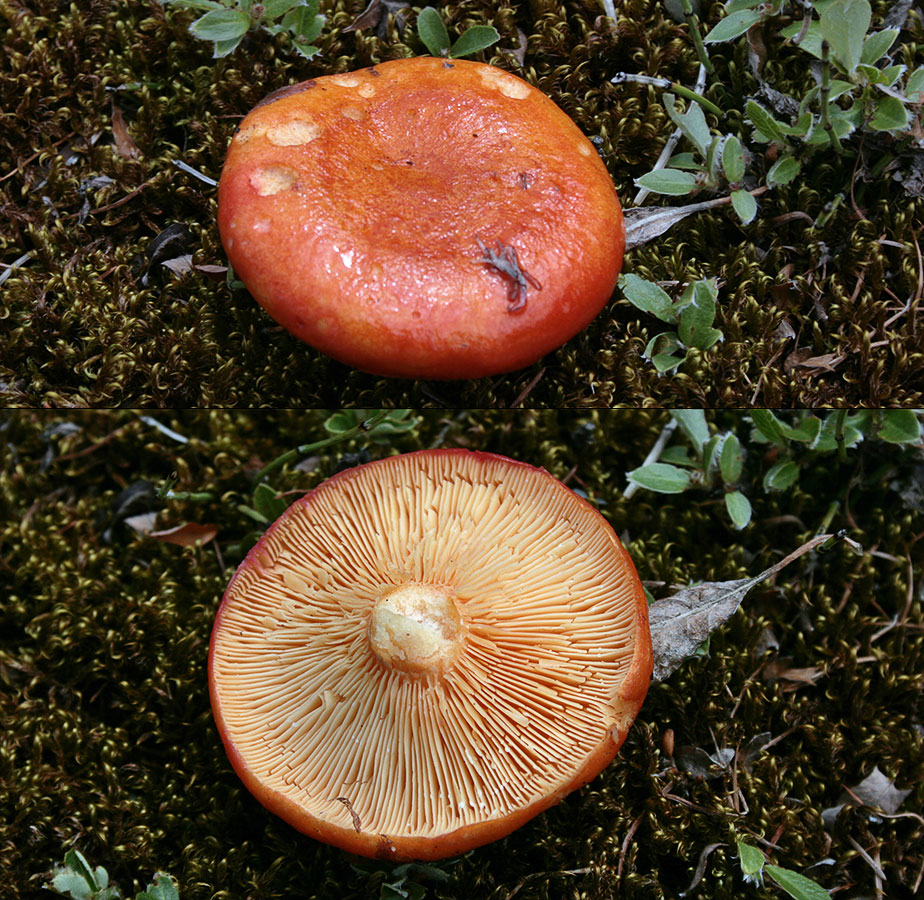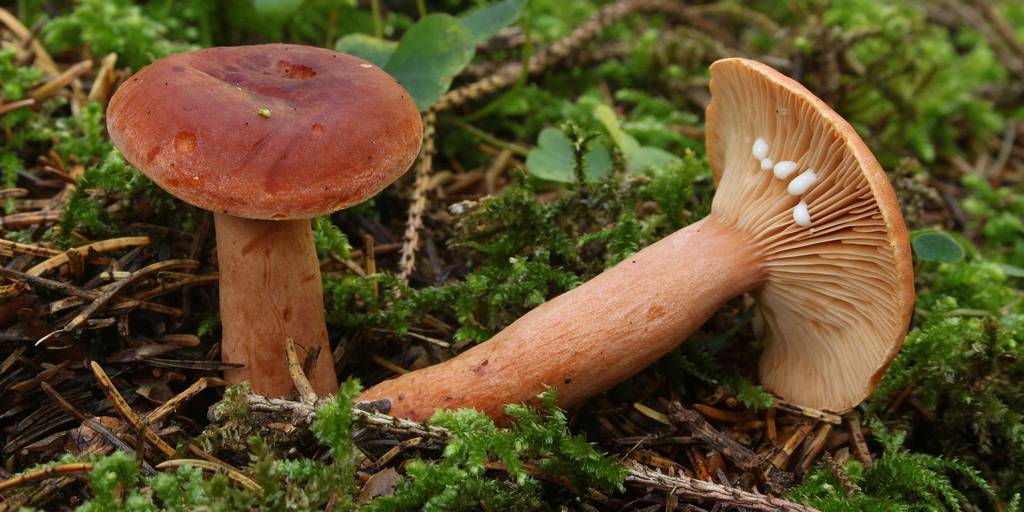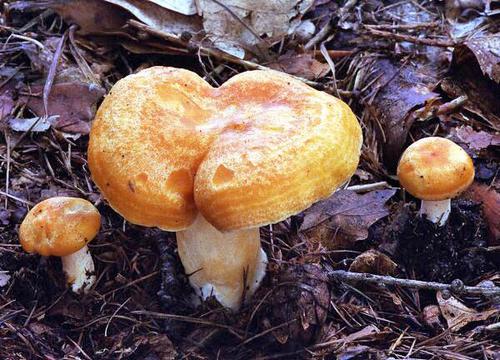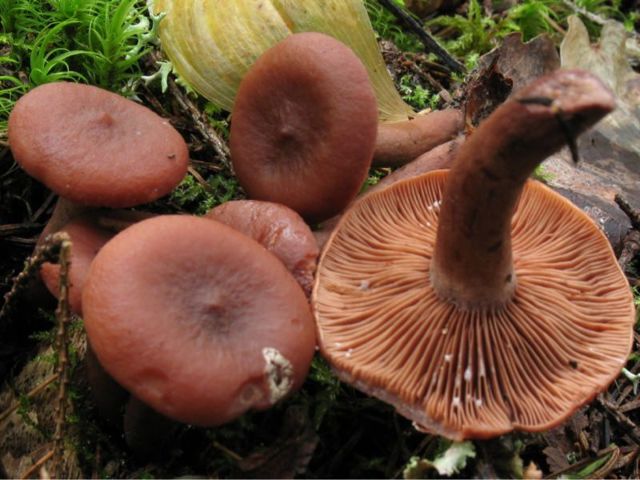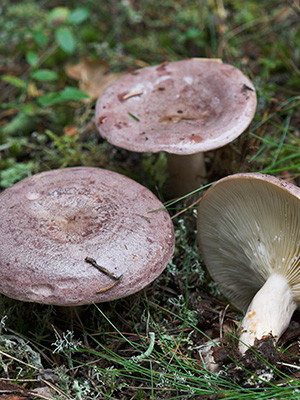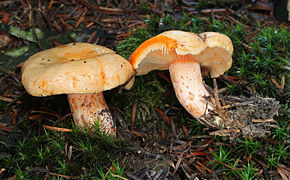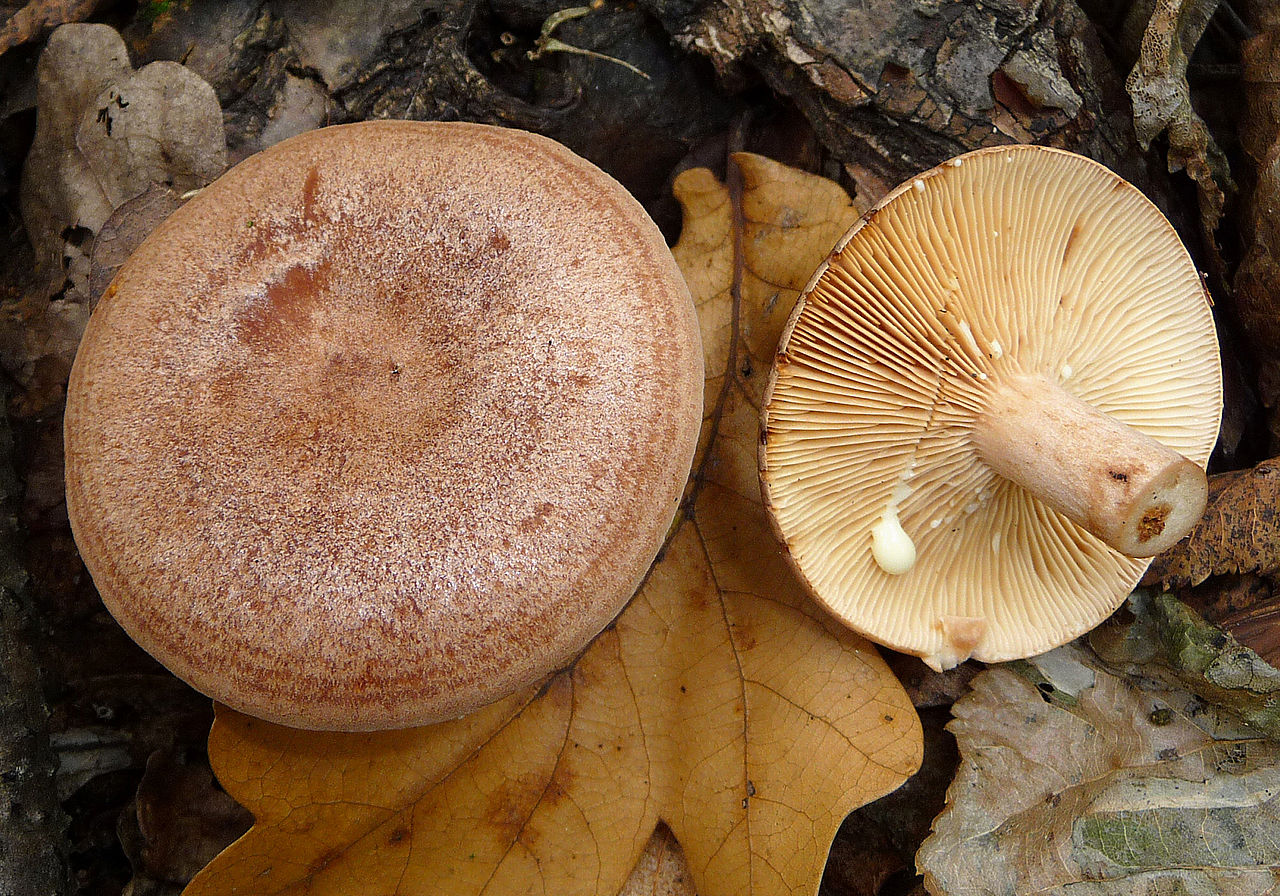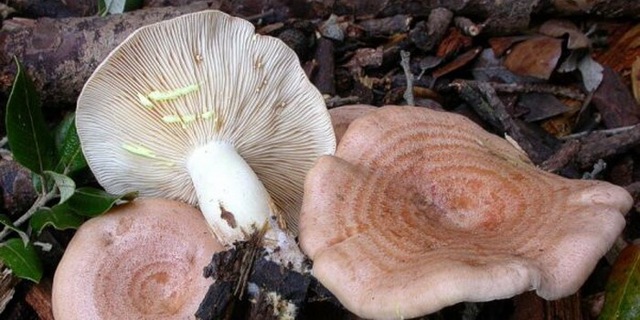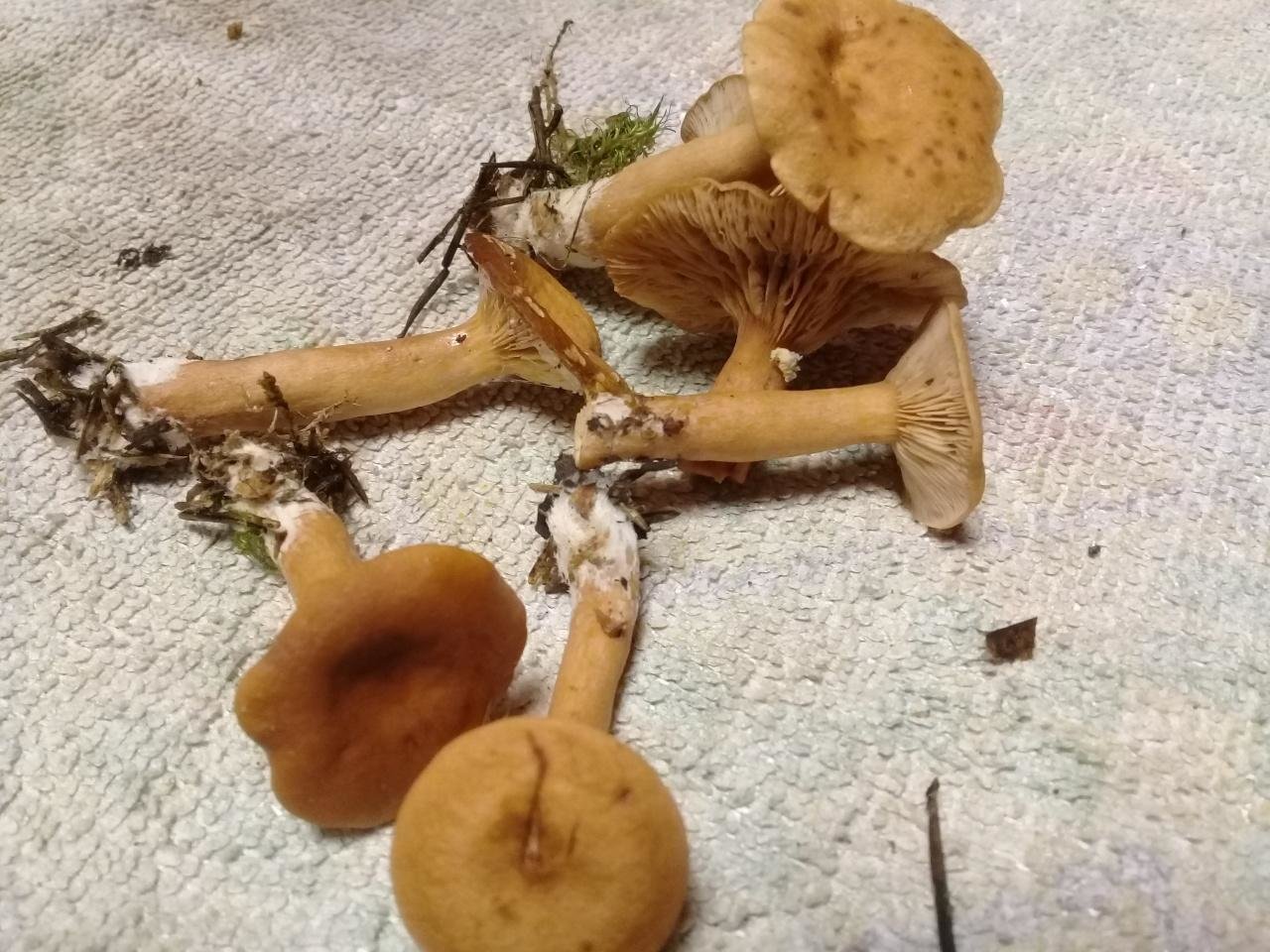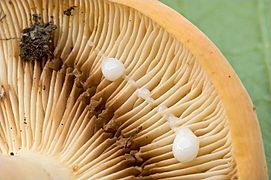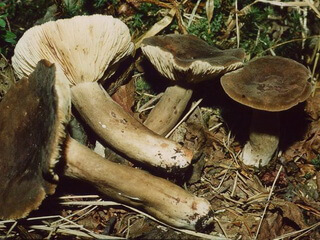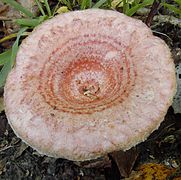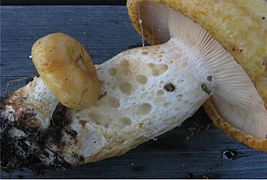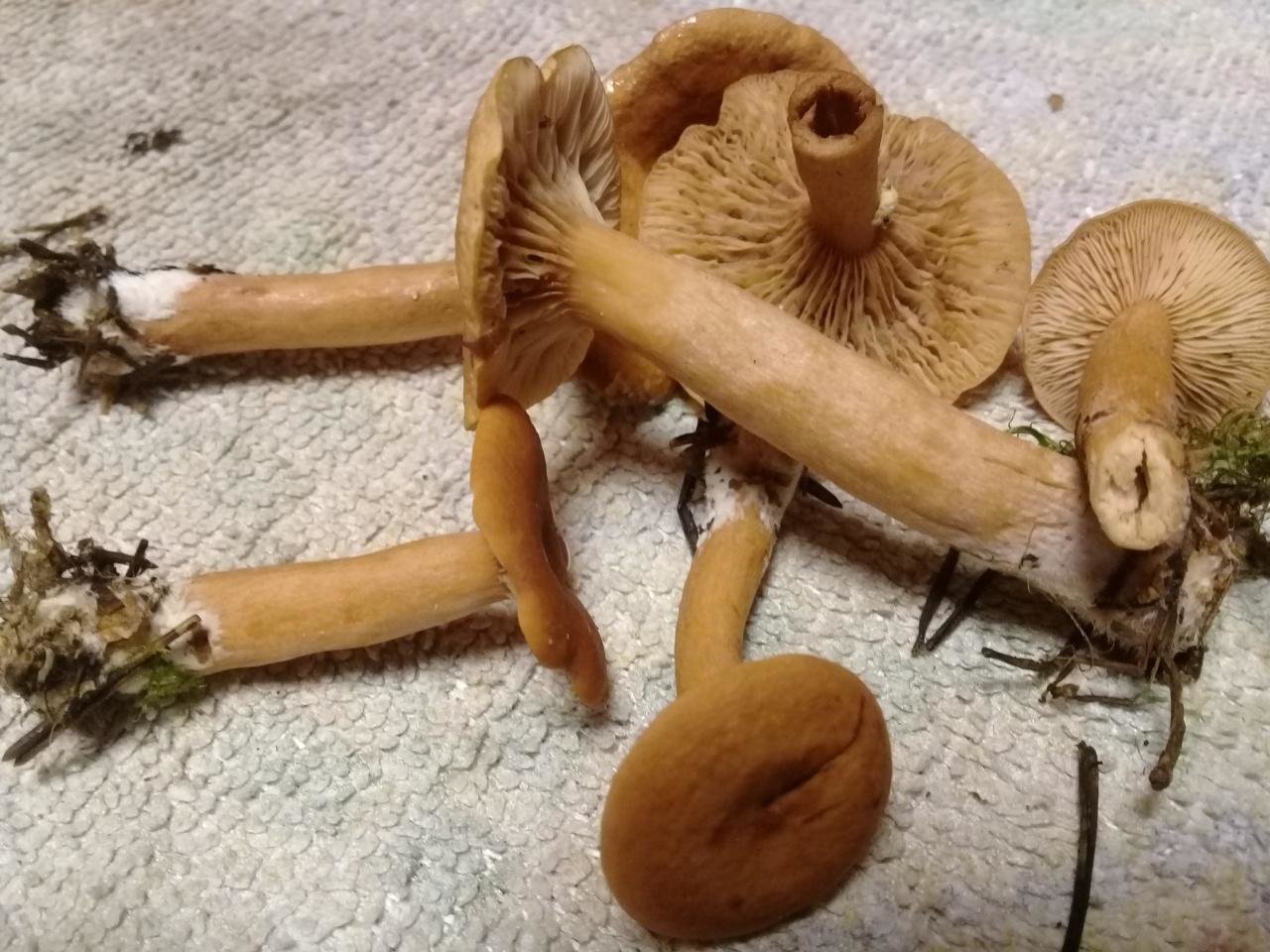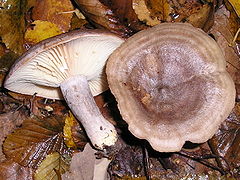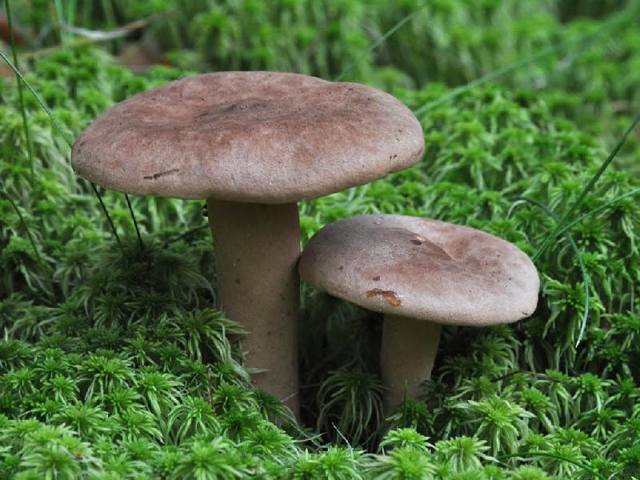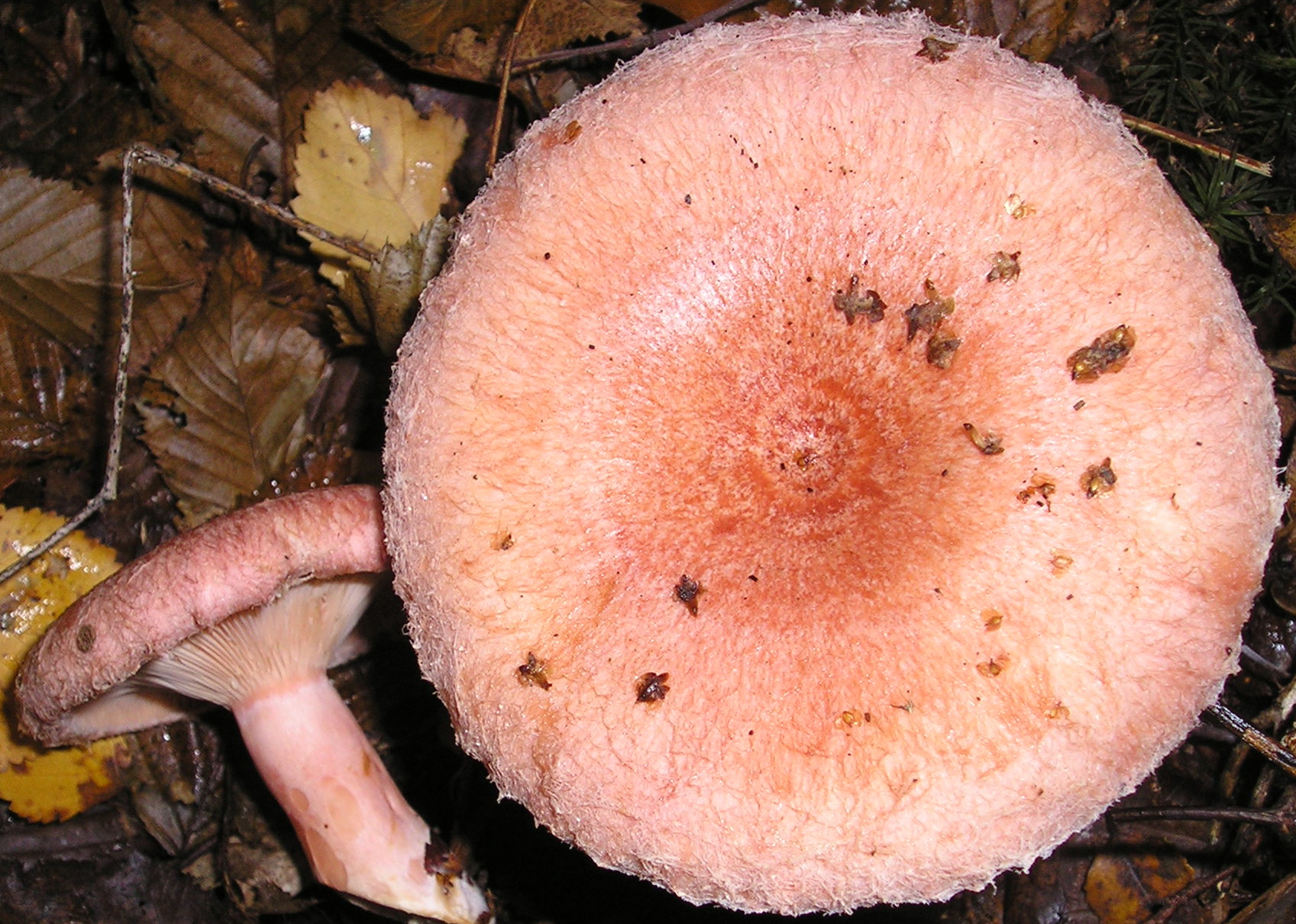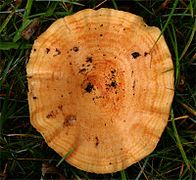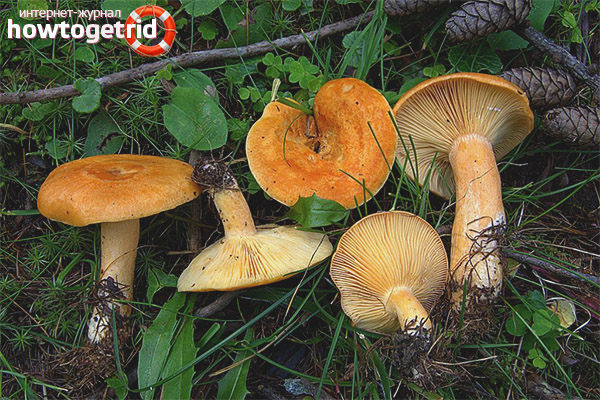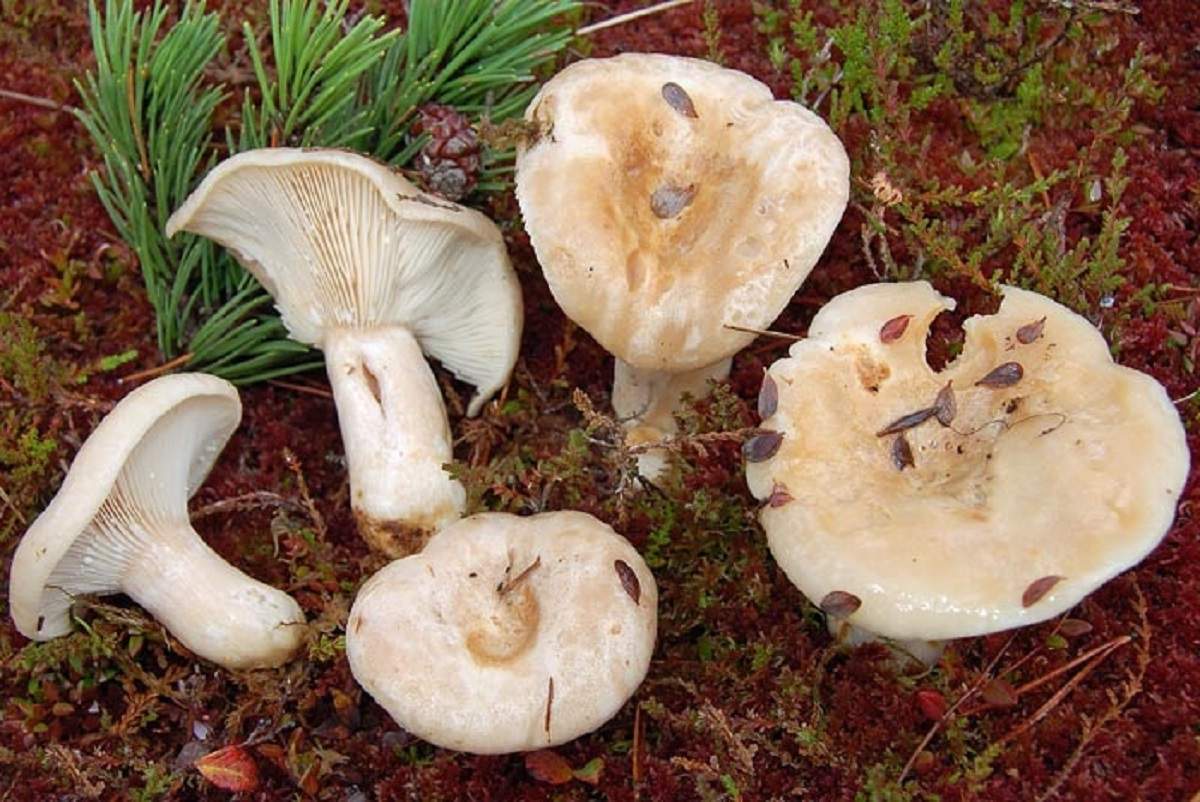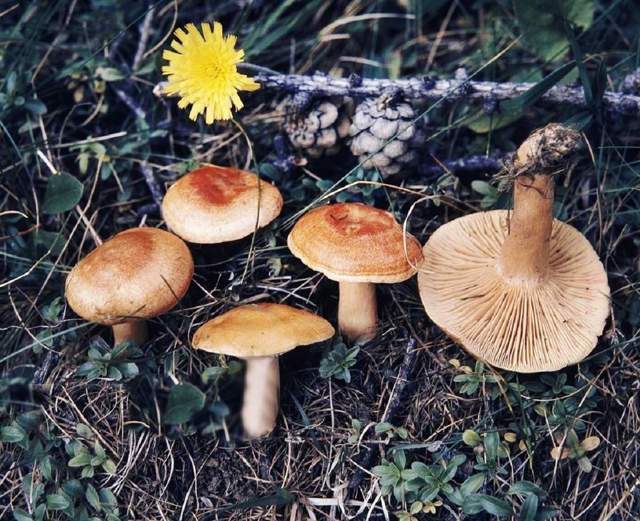Miller pink-gray
| Group: | Lamellar |
| Plates: | White, beige-gray-pink |
| Colour: | Beige-gray-pink |
| Info: | Smells like chicory at the break |
| Department: | Basidiomycota (Basidiomycetes) |
| Subdivision: | Agaricomycotina (Agaricomycetes) |
| Class: | Agaricomycetes (Agaricomycetes) |
| Subclass: | Incertae sedis (indefinite) |
| Order: | Russulales |
| Family: | Russulaceae (russula) |
| Genus: | Lactarius (Miller) |
| View: | Lactarius helvus (Gray-pink Miller) |
According to some sources, this type of milkmen is inedible, and according to others, it is conditionally edible. In foreign literature it is noted as weakly poisonous; in the domestic - as inedible or as edible, but of little value due to a strong unpleasant odor.
Hat
Grows to medium size (up to about 15 cm in diameter). In the middle of it, both an impression and a tuberous outgrowth can form. With the growth of the fungus, both signs appear at the same time. The edges of the cap in young mushrooms are rolled downwards, and open upwards with age. Its color is beige-gray-pink. The surface is not slimy, dry and velvety to the touch.
Pulp
Fleshy, pale and rather fragile. When broken or cut, the pulp smells very strongly of chicory. It tastes bitter. It emits a small amount of milky juice, which resembles water in consistency. The juice does not change color when exposed to air.
Leg
The legs of these milkmen are short and very stocky (approximately 8 * 2). Their color is slightly lighter than the surface of the cap. In young specimens, the legs are full, and in the process of growth they form irregular cavities inside. These milkmen do not have any additional growths on the legs, they are smooth.
Spore-bearing layer
The spore layer is made of plates. Plates of medium thickness and frequency. Almost the same color as the hat, but a little lighter. In very young mushrooms, the plates are almost white, then darken.
Spore powder
The spores of the gray-pink lactarius are almost round, of medium size, with a reticular surface, the bulk of the powder is orange-yellow.
Distribution and collection
The gray-pink milky is distributed throughout the northern hemisphere in a temperate climate. Usually it forms mycorrhiza with conifers such as pine or spruce, but in other conditions it can grow next to deciduous, in particular, birch. This species prefers acidified soils, which are usually found in thickets of blueberries and near swamps.
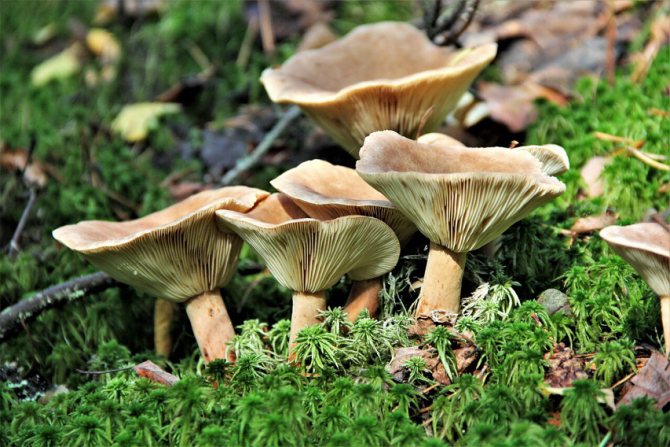
Similar species
This type of milkman has practically no twins due to its extremely specific smell.
But outwardly, it may look like:
It features an implicit concentric pattern on the head. In addition, the smell is different - the oak milkman smells like hay, not chicory. In general, this mushroom is smaller and grows mainly near oak trees.
This mushroom is also distinguished by a more modest size and a darker color, predominantly brownish-red. Doesn't smell like chicory like the gray-pink variety.

Similar species
This type of milkman has practically no twins due to its extremely specific smell.
But outwardly, it may look like:
It features an implicit concentric pattern on the head. In addition, the smell is different - the oak milkman smells like hay, not chicory. In general, this mushroom is smaller and grows mainly near oak trees.
This mushroom is also distinguished by a more modest size and a darker color, predominantly brownish-red. Doesn't smell like chicory like the gray-pink variety.
 1- Oak Milky 2- Bitter
1- Oak Milky 2- Bitter
The gray-pink milky does not look like obviously poisonous mushrooms, so you cannot confuse him with them.
Description
- The hat can be up to 8 cm in diameter, but in fact the top does not grow more than 6 cm. The height of the base is about 5 cm on average and 2 cm wide. There are plates on the inside of the hat.They are not too wide, but not narrow either, they are located at a close distance to each other, slightly lowered. The plates contain yellow colored spore powder.
- In young animals, the tops protrude. However, over time, they straighten out and take on a depressed format. Eventually, the mushroom hat looks like a funnel. The upper part has an orange skin. It is smoothed, matte with a slight sheen in a chaotic manner. It becomes slippery when grown in moisture.
- Leg by cylinder format. Tapers towards the bottom. In young animals, it is lightened, in shade similar to a hat. When the mushroom grows and matures, its base becomes empty inside. These mushrooms secrete a lot of juice, which is distinguished by its density. It is sticky, pungent, colored in a light tone, and does not change in color when weathered. Fibrous pulp, smells like orange.
Useful properties, medical applications and restrictions on use
Milk mushrooms have long been used in folk medicine for the treatment of purulent wounds, kidney diseases and other diseases. Most of the species have anti-tumor and antibacterial effects. The fruit contains vitamins that have a beneficial effect on the nervous system and prevent the development of sclerosis.
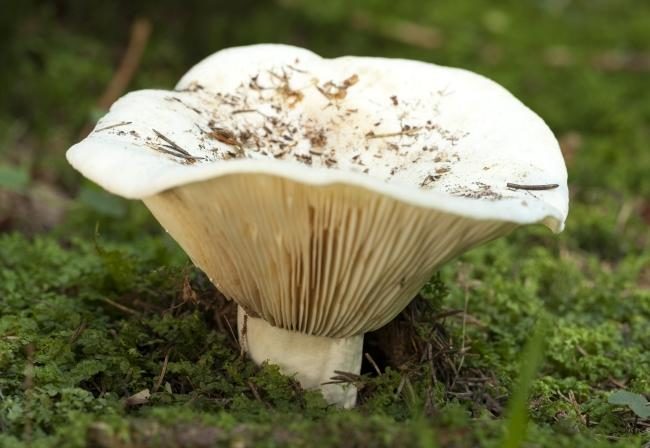
Lactose
Medicines made on the basis of milk mushrooms help cope with kidney stones. The blue milk mushroom contains a natural antibiotic that has a detrimental effect on staphylococci. In some fruits, scientists have discovered lactarioviolin, an antibiotic that helps to destroy the pathogens of tuberculosis.
Most of the mushrooms of this genus are conditionally edible fruits, so they need to be heat treated before eating. You cannot harvest near highways, factories and plants, it is better to do this in ecologically clean areas. It is not advised to eat these fruits for gastrointestinal diseases, pregnancy and breastfeeding.
Recipes and cooking features
Mushrooms of this kind can be fried, boiled and pickled, but in this form their taste is muted. Salty and fermented milkers are characterized by good taste. Ryzhiks do not require prolonged soaking, but bitters, milk mushrooms and waves should be soaked for a while in cold water.
Here are some delicious recipes:
- If the basket is filled with mushrooms, this is a great reason to please loved ones with fried mushrooms. The crop is washed and cleaned from forest debris. Each copy is cut into 5-7 pieces and laid out in a preheated pan with sunflower oil.
Fried mushrooms The fire should be medium so that the water from the mushroom mass evaporates faster. When the water has boiled off, reduce the heat and fry for about 15 minutes. At this time, you can add finely chopped onion, salt and fry for about another five minutes.
- To prepare delicious Korean mushrooms, you will need the following ingredients:
- milkmen (any bitter mushrooms);
sugar;
soy sauce;
table vinegar;
fresh garlic;
hot pepper;
ground coriander.
Millers in Korean
The fruits are pre-boiled 2-3 times for 30 minutes, each time changing the water. It is desirable that a slightly bitter taste remains in them, which will give the dish a special piquancy. Boiled fruits are seasoned with soy sauce, sugar and a little vinegar are added. The resulting mass is thoroughly mixed with the addition of the necessary spices. The finished dish should be allowed to brew for several hours in the refrigerator.
Useful properties of the lactarius
Mushrooms of the genus lactic acid have been a food product for people in many countries of the world for a long time, especially in the northern regions of Eurasia. They are also famous for their medicinal and prophylactic properties:
- Many types of these mushrooms are valuable for the antibiotics they contain.
- The B vitamins found in mushrooms have a beneficial effect on the human nervous system and help resist the development of sclerosis.
- Medicines made on the basis of milk mushrooms help with kidney stones.For example, blue milk (canine) contains antibacterial substances that can kill staphylococci. Russian folk healers treated kidney diseases, purulent wounds and other ailments with milk mushrooms.
Calorie content of fresh milk mushrooms: 100 grams of mushrooms contains 16 kcal. The following substances are present in this volume of mushrooms:
- 88 g of water;
- 1.8 g protein;
- 0.8 g fat;
- 0.5 g of carbohydrates;
- 1.5 g fiber;
- 0.4 g of ash;
- Vitamins B1, B2, C, PP;
- Amino acids tyrosine, glutamine, arginine, leucine.
100 grams of fresh waves contain 22 kcal. This amount of mushrooms contains:
- 92.31 g water;
- 3.09 g protein;
- 0.34 g fat;
- 3.26 g carbohydrates;
- 1 g fiber
- vitamins: C, B1, B2, PP, B5, B6, B9, B12, E, D, D2, K1;
- minerals: selenium, calcium, magnesium, iron, potassium, sodium, phosphorus, zinc, copper, manganese;
- choline, betaine.
Calorie content of mushrooms: 100 grams of fresh mushrooms - 17 kcal. The mushrooms contain:
- 88.9 g water;
- 2.9 g protein;
- 0.8 g fat;
- 2 g carbohydrates;
- 2.2 g dietary fiber;
- 0.7 g of ash;
- Vitamins: B1, B2, C, PP, beta-carotene. By the way, the orange color of the mushrooms is due to the high content of beta-carotenes;
- Minerals: magnesium, phosphorus, potassium, iron, sodium, calcium;
- The antibiotic substance lactrioviolin, which suppresses the development of most bacteria, including tubercle bacillus. This antibiotic was isolated from red camelina.
Calorie content of bitter: per 100 g of fresh mushrooms - 22 kcal. The mushroom is rich in nutrients, it contains:
- 92.45 g of water;
- 2.18 to 3.09 g of protein;
- 0.34 g fat;
- 3.26 g carbohydrates;
- 1 g fiber
- vitamins: C, B1, B2, B3, B5, B6, B12, E, D, K;
- minerals: potassium, magnesium, phosphorus, iron, calcium, sodium, zinc, manganese, copper, selenium;
- choline, folate;
- antibiotic that kills Staphylococcus aureus.
The milk mushrooms are yellow.
Description
This mushroom is somewhat similar in structure to a bitter, but differs from it in a lighter color.
Hat
 Grows to medium size (up to about 15 cm in diameter). In the middle of it, both an impression and a tuberous outgrowth can form. With the growth of the fungus, both signs appear at the same time.
Grows to medium size (up to about 15 cm in diameter). In the middle of it, both an impression and a tuberous outgrowth can form. With the growth of the fungus, both signs appear at the same time.
The edges of the cap in young mushrooms are rolled downwards, and open upwards with age. Its color is beige-gray-pink. The surface is not slimy, dry and velvety to the touch.
Pulp
Fleshy, pale and rather fragile. When broken or cut, the pulp smells very strongly of chicory. It tastes bitter. It emits a small amount of milky juice, which resembles water in consistency. The juice does not change color when exposed to air.
H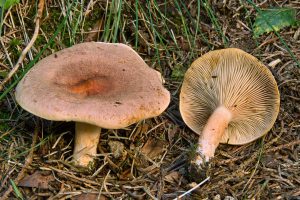 burn
burn
The legs of these milkmen are short and very stocky (approximately 8 * 2). Their color is slightly lighter than the surface of the cap. In young specimens, the legs are full, and in the process of growth they form irregular cavities inside. These milkmen do not have any additional growths on the legs, they are smooth.
Spore-bearing layer
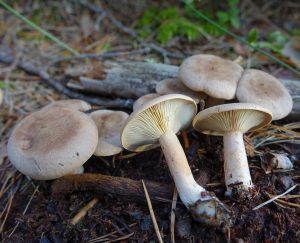
The spore layer is made of plates. Plates of medium thickness and frequency. Almost the same color as the hat, but a little lighter. In very young mushrooms, the plates are almost white, then darken.
Spore powder
The spores of the gray-pink lactarius are almost round, of medium size, with a reticular surface, the bulk of the powder is orange-yellow.
Poisonous and inedible species of milky mushroom
Sticky Miller (Lactárius blénnius)

Inedible mushroom.
The diameter of the cap is 4-10 cm, the shape is convex, later extended, the edge is curved. The surface of the cap is shiny, sticky, gray-green in color with dark concentric zones. Leg 4-6 cm long, 2.5 cm in diameter, light. The pulp is white, odorless, the taste is sharp, peppery. Milky juice is thick, white.
Mycorrhiza forms with deciduous trees, grows in summer and autumn in small groups in deciduous forests of Europe and Asia.
Gray-pink Miller (Lactárius hélvus)
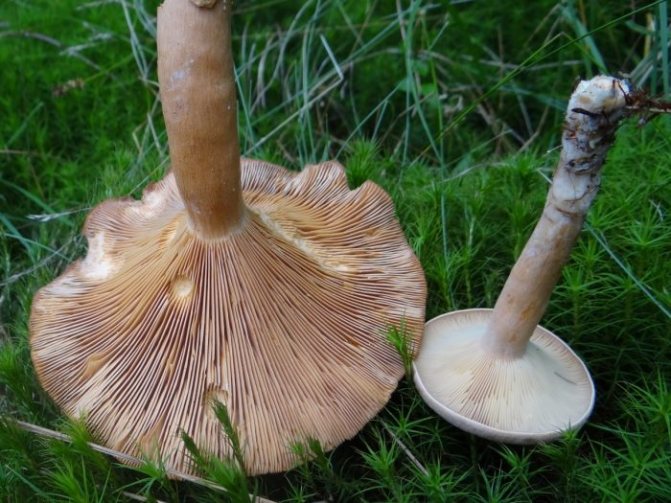
Inedible mushroom.
The cap is 6-12 cm in diameter, the shape is flat, later funnel-shaped, the edge is curled up. The color is pinkish brown. The leg is 9 cm high, 1.5-2 cm thick, cylindrical in shape, the color matches the cap. The pulp is light yellow in color. The smell is strong, spicy, unpleasant. The taste is bitter.Milky sap is watery white.
Grows in coniferous forests in the northern temperate zone. The fruiting season is from July to September.
Liver miller (Lactárius hepáticus)
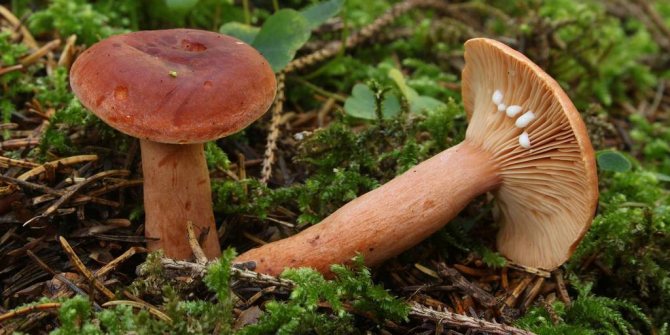
Inedible mushroom.
Hat 3-6 cm in diameter, liver-brown color, smooth surface. The leg is 3-6 cm in height, 0.6-1 cm in thickness, cylindrical in shape, color like a cap. The flesh is thin, creamy or light brown in color, acrid.
Forms mycorrhiza with pine.
Dark Miller (Lactárius obscurátus)
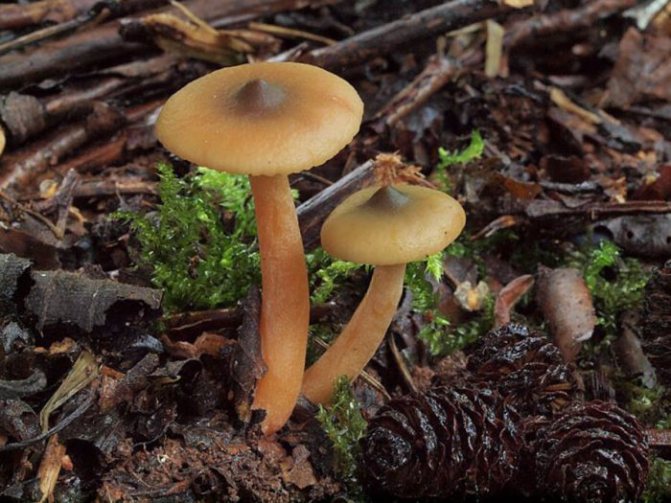
Inedible mushroom.
The cap is 1.5-3 cm in diameter, in a young fungus it is flat, later goblet, the edge is wrinkled, the surface is matte, the color is ocher-brown. The leg is 0.5 cm in diameter, 2-3 cm in height, cylindrical in shape, color like a cap. The pulp is brittle, brown in color. Milky juice is white.
Grows in mixed and deciduous forests, from mid-July to September.
Resinous black miller (Lactárius pícinus)

Inedible mushroom.
The hat is 4-10 cm in diameter, the shape is convex, later spread out. The surface is velvety, brownish brown. The leg is 3-6 cm high, 1-1.5 cm thick, cylindrical in shape, tapering towards the base. The pulp is white, dense, the smell is weak, fruity, the taste is sharp, peppery, turns pink in the air. The milky juice is thick, white, turns red in air.
Grows in small groups or singly in coniferous and mixed forests. The season starts in mid-August and lasts until the end of September.
Orange Miller (Lactárius pornínsis)
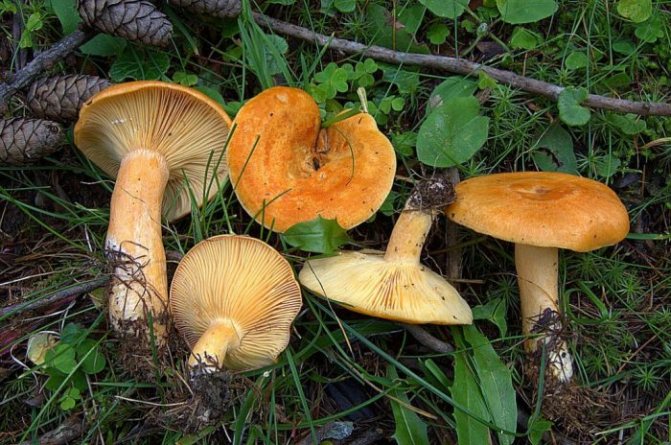
Inedible mushroom.
The hat is 3-8 cm in diameter, the shape is convex. Orange color, smooth surface.
The leg is 3-6 cm long, 0.8-1.5 cm in diameter, cylindrical in shape, tapering towards the base, in a young mushroom it is solid, later hollow, the color coincides with the cap. The pulp is dense, fibrous, the smell is orange. Milky juice is thick, sticky, white.
Grows in deciduous forests, in small groups, in summer and autumn.
Wet Miller (Lactárius úvidus)
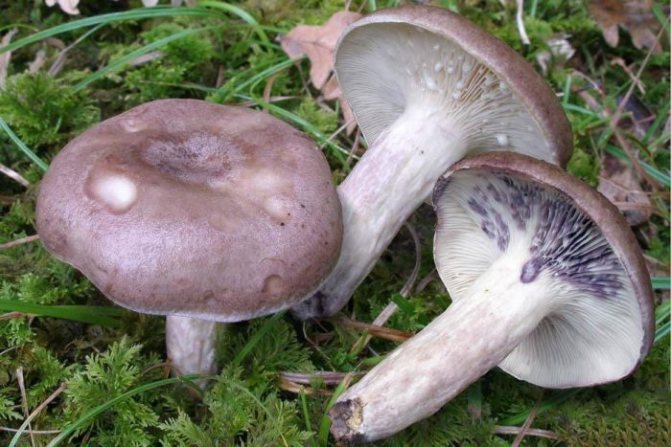
Inedible mushroom.
The diameter of the cap is 4-8 cm; in a young mushroom, the shape is convex, later prostrate. The edge is bent. The color is grayish-steel with a violet tinge, the surface is smooth and damp. The pulp is odorless, the taste is pungent, white or yellowish, turns purple on the cut. Milky juice is abundant, white, turns purple in air. The leg is 4-7 cm high, 1-2 cm thick, strong, cylindrical.
A rare mushroom that grows in damp deciduous and mixed forests, from early August to late September.
Evaluation of taste and recipes for the preparation of oak milkman
Like other milkmen, oak is primarily used for pickling and pickling. Prolonged soaking, as well as the use of vinegar in the preparation, allows you to neutralize a special toxic substance contained in these mushrooms - lactarins. An alternative method to protect yourself from possible ailments after eating oak milkman is heat treatment (boiling). These measures not only increase the edibility of the mushroom, but also improve its taste.
Primary processing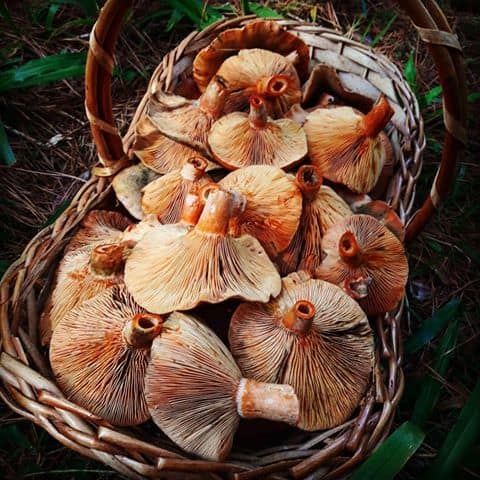
The traditional way to prepare mushrooms for pickling and pickling is to soak in cold water. The fruit bodies, previously cleaned of dirt and damaged areas, are poured with water and pressed down with a plate with a load so that the mushrooms do not float up. The duration of the procedure is at least a day (ideally 2-3 days). To avoid acidification, it is recommended to change the water every 10–12 hours, if the room temperature is high, then more often.
Cooking
It is an alternative method of primary processing of the oak milkman. The peeled mushrooms are boiled in boiling salted water for 15–20 minutes. After that, they are thrown back in a colander and washed under running water.
Frying
Not everyone will decide on such a culinary experiment, but theoretically, you can cook a roast from pre-soaked or boiled milkmen. Onions, garlic and potatoes can be added to enhance the flavor.
Salting
Mushrooms are laid out on the bottom of a non-metallic dish in layers sprinkled with salt. Many housewives add bay leaves and black peppercorns for taste.Oppression is installed on top of the mushrooms, and the workpiece itself is sent to a cool shaded place. After 7-10 days, you can put the pickles in the jars, but they will be ready for use only after a month.
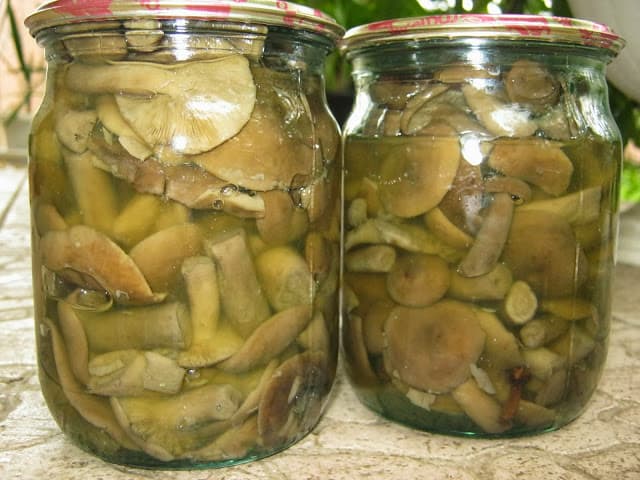
Drying
Like any lamellar mushroom, oak milky is rarely dried for the winter, since with this method of processing the final product, very little comes out.
For drying, use special electric dryers or an oven. The mushrooms, cut into pieces, are laid out on a wire rack so that they do not come into contact with each other. Set the temperature to about 50 degrees, preferably with convection mode. Readiness is determined by the properties of the processed mushrooms - they must be sufficiently dry, but elastic.
Care features
- Poultry tailed poultry calmly refers to watering, although it is recommended to regularly moisten the soil during the growth period. It feels great on any soil. But if there is not enough light, it will definitely perish.
- In the summer, the plants are taken out onto the balcony. It is better to grow a poultry farm on the site, since it does not form seeds at home.
- During the growth of the plant, fertilizing with nitrogenous fertilizers should be carried out. After the bulbs and leaves have formed, you can feed the poultry farm with fertilizers for flowering plants.
- The plant tolerates winter well. It is not required to cover it. If you leave your poultry house in pots at home in winter, move it away from heat sources - radiators. Watering for the winter must be reduced. In this case, it is worth making sure that the soil does not dry out completely.
- Dead leaves must be carefully removed. If the leaf is not completely wilted, it is better not to touch it, this can harm the plant.
- During flowering and boll formation, watering should be reduced.
- Spraying is not worth it, you can just wipe the leaves with a cloth.
- Thinning of plants in the open field should be carried out every 4 years.



